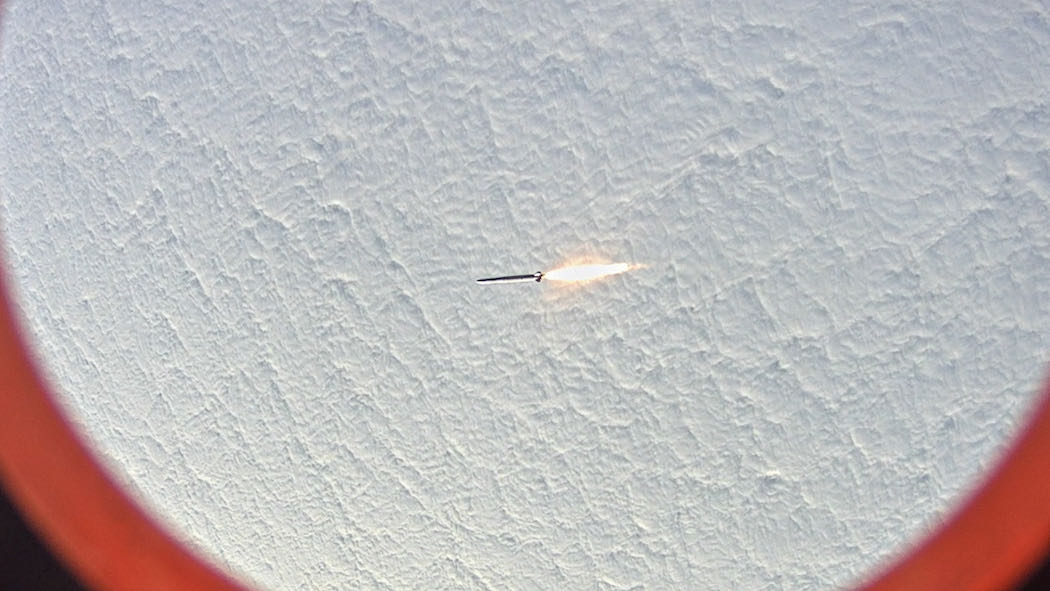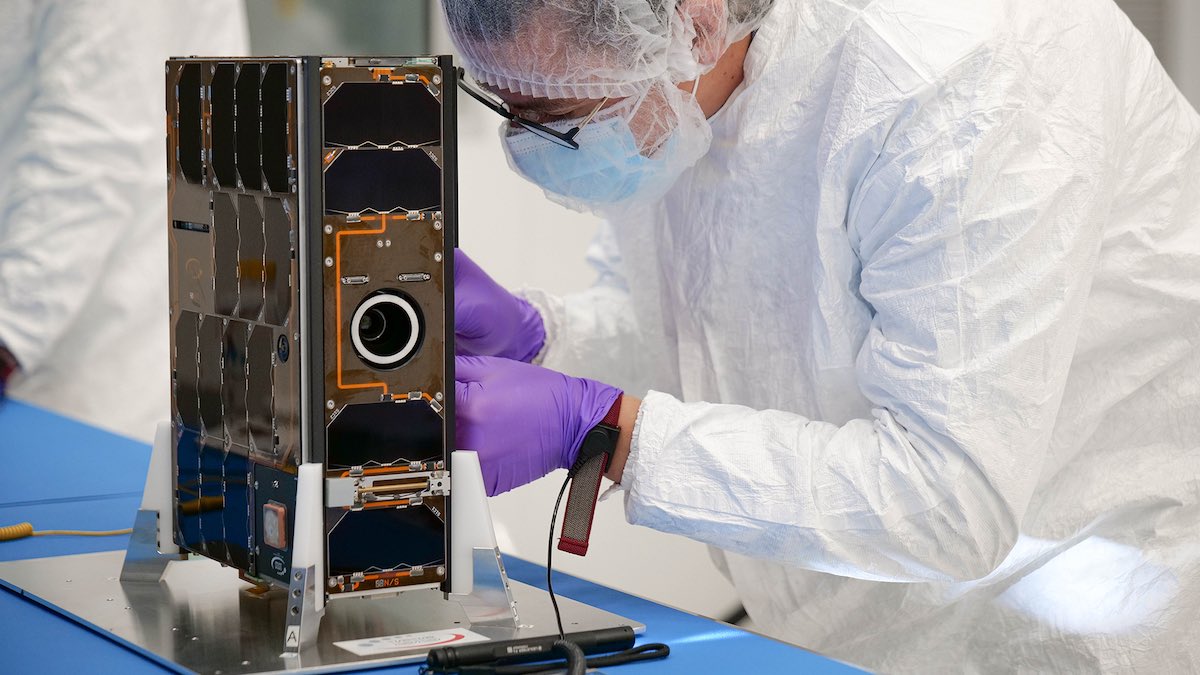
Virgin Orbit’s air-launched rocket aced its first operational mission Wednesday, firing into orbit from the wing of a 747 carrier jet southwest of Los Angeles to deploy small satellites for the U.S. Army, Navy, the Missile Defense Agency, the Dutch military, and the Polish company SatRevolution.
The mission was the third flight of Virgin Orbit’s expendable LauncherOne rocket. A first launch in May 2020 failed to reach orbit due to an engine problem shortly after ignition, but a second test flight in January successfully placed a cluster of NASA-sponsored CubeSats into orbit.
That gave Virgin Orbit confidence to proceed into commercial service, and Wednesday’s mission opens the door one more LauncherOne flight later this year and up to six missions in 2022, according to Dan Hart, the company’s CEO.
Ground crews filled the LauncherOne rocket with its liquid propellant mix of kerosene and liquid oxygen at Mojave Air and Space Port in California early Wednesday. After final checks, managers cleared the Boeing 747 carrier aircraft, named “Cosmic Girl,” for departure from the runway at Mojave around 6:50 a.m. PDT (9:50 a.m. EDT; 1350 GMT).
With a crew of five, the Cosmic Girl carrier aircraft flew to the mission’s launch zone just south of the Channel Islands southwest of Los Angeles. The pilots guided the jumbo jet through the drop box for a “cold pass” to check winds and ensure mission control had a stable telemetry link with the rocket.
The aircraft then circled back in a “race track” pattern and lined up with the proper launch azimuth to the southeast.
Pilot Kelly Latimer pitched the 747 up at an angle of nearly 30 degrees before the rocket dropped from a pylon on the airplane’s left wing at an altitude of about 35,000 feet (10,700 meters).
Five seconds later, the rocket’s NewtonThree main engine ignited to propel LauncherOne into space. The kerosene-fueled engine produced more than 70,000 pounds of thrust at maximum power, and fired for more than three minutes before shutdown.
The rocket’s first stage then separated to fall into the Pacific Ocean off the coast of Baja California, and the NewtonFour second stage engine fired for more than five minutes to place the mission’s seven CubeSat payloads into a parking orbit.
LauncherOne’s aerodynamic payload shroud jettisoned during the second stage burn.
After shutting off its second stage engine, the rocket soared over the southern part of South America and then headed north again. The NewtonFour engine briefly reignited to reach an orbit with a high point at an altitude of about 310 miles (500 kilometers), and an inclination of about 60.7 degrees to the equator, according to U.S. military tracking data.
The rocket then deployed its seven CubeSat payloads, prompting Virgin Orbit officials to declare the mission a success.
“Two successful launches and two groups of happy customers in five months really speaks to our team’s abilities,” Hart said in a statement. “They’re making air launch look easy, and I can tell you from experience that it’s not.
“We can now proudly say that 17 satellites launched by our system are up in space exactly in their target orbits,” Hart said. “We’re looking forward to growing that number tremendously as we push to ramp up our flight cadence in the coming months.”
Founded by billionaire Richard Branson, Virgin Orbit developed the LauncherOne rocket using private money. The rocket stretches about 70 feet (21 meters) long and is capable of placing up to 1,100 pounds (500 kilograms) of cargo into a low-altitude, low-inclination orbit.
That puts Virgin Orbit in competition with other smallsat launch companies, such as Rocket Lab.
“Today is Virgin Orbit’s day,” Branson said in the company’s launch webcast. “Now they have their second rocket into orbit, it’s now hopefully going to become almost routine, and they’ll be able to put more and more and more satellites, more and more and more rockets into space, and just build up that number.
“We know the system fundamentally works,” Branson said. “There are so many people that need satellites in space, and we’re going to be able to deliver.”
In a conference call with reporters before launch this week, Hart said the company plans at least one more LauncherOne mission based out of Mojave this year. Virgin’s plans for up to six launches next year include missions staged out of Guam and Cornwall in England, Hart said.
He said Virgin Orbit has five rockets under construction at the company’s factory in Long Beach, California.
“Now it’s a matter of just continuing to ramp up the gas, if you will, in the factory, and moving rockets through integration,” Hart said.
Virgin Orbit is also discussing plans for launching missions from airports in Brazil, Italy, and Japan.
“We do anticipate additional aircraft, and and perhaps some additional sets of portable equipment that we can package into those aircraft and fly to wherever we want to take off,” Hart said. “So we do have plans for expansion. Some of that will start getting going as early as next year.”
The company is also developing a third stage to carry heavier payloads into orbit. The third stage could also deliver spacecraft to higher altitudes, and perhaps even the moon and other planets.

The seven payloads riding on Wednesday’s mission included CubeSats from the U.S. military, the Dutch military, and the Polish company SatRevolution.
Four of the CubeSats were manifested on the mission by the Department of Defense’s Space Test Program. The payloads are part of the STP-27VPA mission awarded to VOX Space, a Virgin Orbit subsidiary charged with marketing launch services to the U.S. government.
The military’s Defense Innovation Unit awarded the contract to VOX Space for the STP-27VPA mission.
One of the U.S. military payloads was a Gunsmoke-J technology demonstration satellite for the Army Space and Missile Defense Command, according to a Space Force spokesperson. The 3U CubeSat, about the size of a toaster oven, is designed to demonstrate how small satellites can respond to Army requirements, such as providing tactical imagery and data to battlefield commanders.
The Space Force spokesperson said there were two 3U CubeSats on-board Wednesday’s mission for the Missile Defense Agency. The CubeSat Network Communications Experiment Block 1, or CNCE Blk 1, payloads “will replicate an advanced on-orbit concept of operations involving satellite-to-satellite communications and satellite-to-ground communications in the space environment,” the spokesperson said.
The CNCE Blk 1 satellites will support experiments in “autonomous mesh networking,” according to the Missile Defense Agency.
The other U.S. military payload launched Wednesday was a 3U CubeSat for the Navy, the Space Force spokesperson said.
Col. Carlos Quinones, director of the Space Test Program, identified the payload as the Halo-NET Free Flyer satellite during Virgin Orbit’s launch webcast.
According to a regulatory filing with the Federal Communications Commission, Hal0-NET Free Flyer will test the survivability and reflectivity of a retroreflector array. The data will help engineers validate optical propagation models and influence the design of future optical communications payloads for the Navy, officials wrote in thee FCC filing.
Quinones said missions like Wednesday’s launch are designed to give the military more options for small satellite launches.
“For us, it’s about flexibility and it’s about bringing different types of opportunities,” Quinones said. “In the case of what VOX brings, it’s a unique opportunity, it provides a small launch through aircraft deployment, which provides flexibility.”
The airborne launch system provides options to use different launch sites and place payloads into different types of orbits. There are also benefits in flying around weather that could delay a ground-based launch, Quinones said.
The BRIK 2 nanosatellite for the Royal Netherlands Air Force also launched on Virgin Orbit’s LauncherOne rocket.
The small satellite is slightly bigger than a carton of milk, according to the Dutch Ministry of Defense. Built by the Dutch company Innovative Solutions in Space, BRIK 2 is the Dutch military’s first satellite. Dutch officials say the primary goal of the project is to demonstrate that small satellites like BRIK 2 can support information and communications applications for the military.
Other partners on the BRIK 2 mission include the Royal Netherlands Aerospace Center, which developed a signals intelligence payload for detecting and locating the source of radio waves, such as military radar installations. The satellite also has an instrument to map disturbances in the ionosphere, a layer in the upper atmosphere that can impact radio communications, and a payload to relay secure communications from troops to military headquarters.
The aerospace center said in 2017 that the entire BRIK 2 project would cost about 2.5 million euros, or about $3 million, including satellite construction and launch expenses.
Engineers from Delft University of Technology in the Netherlands and the University of Oslo in Norway also contributed to the BRIK 2 mission.
The other two satellites aboard Virgin Orbit’s first operational launch were the STORK 4 and STORK 5 Earth-imaging spacecraft for the Polish company SatRevolution.
Designed for a three-year mission in orbit, the two STORK satellites host optical cameras for remote sensing applications. The instruments will collect multispectral medium-resolution imagery and data for agricultural and energy customers in the United States, Poland, and other countries, according to Virgin Orbit.
SatRevolution is developing a constellation of 14 STORK satellites. The small satellites on Virgin Orbit’s mission were the first two STORK payloads to launch.
“This year, we are launching 14 satellites, and then next year it will be up to 60,” said Grzegorz Zwoliński, co-founder and CEO of SatRevolution.
On the eve of Wednesday’s mission, Virgin Orbit and SatRevolution announced a memorandum of understanding that could pave the way for numerous LauncherOne missions to deploy hundreds of SatRevolution payloads through 2026.
In a press release announcing the agreement, SatRevolution said it aims to launch 1,024 nanosatellites to low Earth orbit by 2026 to provide “round-the-clock Earth Observation, complete manufacturing and management of the satellites, as well as compliance monitoring, and on-site engineering consulting.”
Email the author.
Follow Stephen Clark on Twitter: @StephenClark1.
